Prediction of Grapevine Yield Based on Reproductive Variables and the Influence of Meteorological Conditions
Abstract
1. Introduction
2. Material and Methods
2.1. Temporal and Geographic Delimitation
2.2. Plant Material and Grape Production Data
2.3. Aerobiological Study
2.4. Pollen and Flower Production Study
2.5. Meteorological Data
2.6. Statistical Analysis
3. Results
3.1. Aerobiological Analysis
3.2. Pollen and Flower Production
3.3. Statistical Analysis
4. Discussion
5. Conclusions
Author Contributions
Funding
Acknowledgments
Conflicts of Interest
References
- Galán, C.; Vázquez, L.; García-Mozo, H.; Domínguez, E. Forecasting olive (Olea europaea) crop yield based on pollen emission. Field Crop. Res. 2004, 86, 43–51. [Google Scholar] [CrossRef]
- Oteros, J.; Orlandi, F.; García-Mozo, H.; Aguilera, F.; Dhiab, A.B.; Bonofiglio, T.; Abichou, M.; Ruiz-Valenzuela, L.; del Trigo, M.M.; Díaz de la Guardia, C.; et al. Better prediction of Mediterranean olive production using pollen-based models. Agron. Sustain. Dev. 2014, 34, 685–694. [Google Scholar] [CrossRef]
- Aguilera, F.; Ruiz-Valenzuela, L. A new aerobiological indicator to optimize the prediction of the olive crop yield in intensive farming areas of southern Spain. Agric. For. Meteorol. 2019, 271, 207–213. [Google Scholar] [CrossRef]
- Candau, P.; González, F.J.; Morales, J.; Tomás, C. Polen y productividad. Agricultura-Productos Mediterráneos-Alimentación 1996, 60, 639–641. [Google Scholar]
- Fernández-González, M.; Escuredo, O.; Rodríguez-Rajo, F.J.; Aira, M.J.; Jato, V. Prediction of grape production by grapevine cultivar Godello in north-west Spain. J. Agric. Sci. 2011, 149, 725–736. [Google Scholar] [CrossRef]
- Dalla Marta, A.; Grifoni, D.; Mancini, M.; Storchi, P.; Zipoli, G.; Orlandini, S. Analysis of the relationships between climate variability and grapevine phenology in the Nobile di Montepulciano wine production area. J. Agric. Sci. 2010, 148, 657–666. [Google Scholar] [CrossRef]
- Buttrose, M.S. Fruitfulness in grapevines: Effects of light intensity and temperature. Bot. Gaz. 1969, 130, 166–173. [Google Scholar] [CrossRef]
- Bindi, M.; Fibbi, L.; Gozzini, B.; Orlandini, S.; Miglietta, F. Modelling the impact of future climate scenarios on yield and yield variability of grapevine. Clim. Res. 1996, 7, 213–224. [Google Scholar] [CrossRef]
- Honorio, F.; García-Martín, A.; Moral, F.J.; Paniagua, L.L.; Rebollo, F.J. Spanish vineyard classification according to bioclimatic indexes: Spanish vineyard bioclimatic classification. Aust. J. Grape Wine Res. 2018, 24, 335–344. [Google Scholar] [CrossRef]
- Petoumenou, D.G.; Biniari, K.; Xyrafis, E.; Mavronasios, D.; Daskalakis, I.; Palliotti, A. Effects of Natural Hail on the Growth, Physiological Characteristics, Yield, and Quality of Vitis vinifera L. cv. Thompson Seedless under Mediterranean Growing Conditions. Agronomy 2019, 9, 197. [Google Scholar] [CrossRef]
- Olesen, J.E.; Trnka, M.; Kersebaum, K.C.; Skjelvag, A.O.; Seguin, B.; Peltonen-Sainio, P.; Rossi, F.; Kozyra, J.; Micale, F. Impacts and adaptation of European crop production systems to climate change. Eur. J. Agron. 2011, 34, 96–112. [Google Scholar] [CrossRef]
- Ortega, E.; Dicenta, F.; Egea, J. Rain effect on pollen-stigma adhesion and fertilization in almond. Sci. Hortic. 2007, 112, 345–348. [Google Scholar] [CrossRef]
- Seneviratne, S.I.; Nicholls, N.; Easterling, D.; Goodess, C.M.; Kanae, S.; Kossin, J.; Luo, Y.; Marengo, J.; McInnes, K.; Rahimi, M.; et al. Changes in climate extremes and their impacts on the natural physical environment. In Managing the Risks of Extreme Events and Disasters to Advance Climate Change Adaptation; A Special Report of Working Groups I and II of the Intergovernmental Panel on Climate Change; Field, C.B., Barros, V., Stocker, T.F., Qin, D., Dokken, D.J., Ebi, K.L., Mastrandrea, M.D., Mach, K.J., Plattner, G.-K., Allen, S.K., et al., Eds.; Cambridge University Press: Cambridge, UK; New York, NY, USA, 2012; pp. 109–230. [Google Scholar]
- Intergovernmental Panel on Climate Change IPCC, 2019. Summary for Policymakers. In Climate Change and Land; An IPCC Special Report on Climate Change, Desertification, Land Degradation, Sustainable Land Management, Food Security, and Greenhouse Gas Fluxes in Terrestrial Ecosystems; Shukla, P.R., Skea, J., Calvo Buendia, E., Masson-Delmotte, V., Pörtner, H.-O., Roberts, D.C., Zhai, P., Slade, R., Connors, S., van Diemen, R., et al., Eds.; IPCC: Geneva, Switzerland, 2019; ISBN 978-92-9169-154-8. [Google Scholar]
- Schultz, H.R. Climate change and viticulture: A European perspective on climatology, carbon dioxide and UV-B effects. Aust. J. Grape Wine Res. 2000, 6, 2–12. [Google Scholar] [CrossRef]
- Leolini, L.; Moriondo, M.; Fila, G.; Costafreda-Aumedes, S.; Ferrise, R.; Bindi, M. Late spring frost impacts on future grapevine distribution in Europe. Field Crop. Res. 2018, 222, 197–208. [Google Scholar] [CrossRef]
- Morales-Castilla, I.; García de Cortázar-Atauri, I.; Cook, B.I.; Lacombe, T.; Parker, A.; van Leeuwen, C.; Nicholas, K.A.; Wolkovich, E.M. Diversity buffers winegrowing regions from climate change losses. Proc. Nalt. Acad. Sci. USA 2020, 117, 2864–2869. [Google Scholar] [CrossRef]
- Vasconcelos, M.C.; Greven, M.; Winefield, C.S.; Trought, M.C.T.; Raw, V. The Flowering Process of Vitis vinifera: A Review. Am. J. Enol. Viticult. 2009, 60, 411–434. [Google Scholar]
- Blanco-Ward, D.; Garcia, J.M.; Jones, G.V. Spatial climate variability and viticulture in the Miño River Valley of Spain. Vitis 2007, 46, 63–70. [Google Scholar]
- Orriols, I.; Vázquez, I.; Losada, A. Variedades gallegas. Terruños 2006, 16, 11–18. [Google Scholar]
- Hirst, J.M. An automatic volumetric spore-trap. Ann. Appl. Biol. 1952, 36, 257–265. [Google Scholar] [CrossRef]
- Galán, C.; Cariñanos, P.; Alcázar, P.; Domínguez, E. Spanish Aerobiology Network (REA): Management and Quality Manual; University of Córdoba Publication Service: Córdoba, Spain, 2007; p. 61. [Google Scholar]
- Abreu, I.; Costa, I.; Oliveira, M.; Cunha, R.; de Castro, M. Ultrastructure and germination of Vitis vinifera cv. Loureiro pollen. Protoplasma 2006, 228, 131–135. [Google Scholar] [CrossRef]
- Harst, M.; Cobanov, B.-A.; Hausmann, L.; Eibach, R.; Töpfer, R. Evaluation of pollen dispersal and cross pollination using transgenic grapevine plants. Environ. Biosaf. Res. 2009, 8, 87–99. [Google Scholar] [CrossRef][Green Version]
- Jato, M.V.; Rodríguez-Rajo, F.J.; Aira, M.J.; Tedeschini, E.; Frenguelli, G. Differences in atmospheric trees pollen seasons in winter, spring and summer in two European geographic areas, Spain and Italy. Aerobiologia 2013, 29, 263–278. [Google Scholar] [CrossRef]
- Andersen, T.B. A model to predict the beginning of the pollen season. Grana 1991, 30, 269–275. [Google Scholar] [CrossRef]
- Galán, C.; Ariatti, A.; Bonini, M.; Clot, B.; Crouzy, B.; Dahl, A.; Fernández-González, D.; Frenguelli, G.; Gehrig, R.; Isard, S.; et al. Recommended terminology for aerobiological studies. Aerobiologia 2017, 33, 293–295. [Google Scholar] [CrossRef]
- Meier, U. Growth stages of mono and dicotyledonous plants. In BBCH Monograph, 2nd ed.; Federal Biological Research Centre for Agriculture and Forestry: Bonn, Germany, 2001; p. 158. [Google Scholar]
- Castiñeiras, P.; Vázquez-Ruiz, R.A.; Fernández-González, M.; Rodríguez-Rajo, F.J.; Aira, M.J. Production and viability of Fraxinus pollen and its relationship with aerobiological data in the northwestern Iberian Peninsula. Aerobiologia 2019, 35, 227–241. [Google Scholar] [CrossRef]
- R Core Team. R: A Language and Environment for Statistical Computing; R Foundation for Statistical Computing: Vienna, Austria, 2017; Available online: https://www.R-project.org/ (accessed on 27 February 2020).
- Wei, T.; Simko, V. R Package “Corrplot”: Visualization of a Correlation Matrix (Version 0.84). 2017. Available online: https://github.com/taiyun/corrplot (accessed on 27 February 2020).
- Cappelli, G.; Pagani, V.; Zanzi, A.; Confalonieri, R.; Romani, M.; Fecciad, S.; Pagani, M.A.; Bregaglio, S. GLORIFY: A new forecasting system for rice grain quality in Northern Italy. Eur. J. Agron. 2018, 97, 70–80. [Google Scholar] [CrossRef]
- Singh, J.; Knapp, H.V.; Demissie, M. Hydrologic modeling of the Iroquois River watershed using HSPF and SWAT; Illinois State Water Survey Contract Report 2004-08; Illinois Department of Natural Resources: Springfield, IL, USA; The Illinois State Geological Survey: Champaign, IL, USA, 2004. [Google Scholar]
- Ritter, A.; Muñoz-Carpena, R.; Regalado, C.M. Capacidad de predicción de modelos aplicados a la ZNS: Herramienta informática para la adecuada evaluación de la bondad-de-ajuste con significación estadística. IV Elaboración de modelos descriptivos y predictivos de los procesos. In Estudios de la Zona no Saturada del Suelo Vol. X—ZNS’11; Martínez-Fernández, J., Sánchez-Martín, N., Eds.; Actas de las X Jornadas de Investigación de la Zona no Saturada del Suelo: Salamanca, España, 2011; ISBN 978-84-694-6642-1. [Google Scholar]
- Candau, P.; González, F.J.; Morales, J.; Tomás, C. Forecasting olive (Olea europaea) crop production by monitoring airborne pollen. Aerobiologia 1998, 14, 241–256. [Google Scholar]
- Galán, C.; García-Mozo, H.; Vázquez, L.; Ruiz, L.; Díaz de la Guardia, C.; Domínguez-Vilches, E. Modelling Olive Crop Yield in Andalusia, Spain. Agron. J. 2008, 100, 98–104. [Google Scholar] [CrossRef]
- Cunha, M.; Ribeiro, H.; Abreu, I. Pollen-based predictive modelling of wine production: Application to an arid region. Eur. J. Agron. 2016, 73, 42–54. [Google Scholar] [CrossRef]
- General Assembly of the United Nations. Resolution Adopted by the General Assembly on 25 September 2015; 70/1. Transforming Our World: The 2030 Agenda for Sustainable Development; General Assembly of the United Nations: New York, NY, USA, 2015. [Google Scholar]
- Rodríguez-Rajo, F.J. El Polen Como Fuente de Contaminación Ambiental en la Ciudad de Vigo. Ph.D. Thesis, University of Vigo, Vigo, Spain, 2000. [Google Scholar]
- Cebrino, J.; Galán, C.; Domínguez-Vilches, E. Aerobiological and phenological study of the main Poaceae species in Córdoba City (Spain) and the surrounding hills. Aerobiologia 2016, 32, 595–606. [Google Scholar] [CrossRef]
- Vara, A. Carga Alergénica de la Familia Oleaceae en la Atmósfera de la Ciudad de Ourense y Factores que Influyen Sobre Ella. PhD Thesis, University of Vigo, Ourense, Spain, 2017. [Google Scholar]
- Lebon, G.; Duchêne, E.; Brun, O.; Clément, C. Phenology of flowering and starch accumulation in grape (Vitis vinifera L.) cuttings and vines. Ann. Bot. 2005, 95, 943–948. [Google Scholar] [CrossRef] [PubMed]
- Dokoozlian, N.K. Grape Berry Growth and Development. In Raisin Production Manual; Agricultural and Natural Resources Publication 3393; Christensen, L.P., Ed.; University of California: Oakland, CA, USA, 2000; pp. 30–37. [Google Scholar]
- Buttrose, M.S.; Hale, C.R. Effect of temperature on development of the grapevine inflorescence after bud burst. Am. J. Enol. Vitic. 1973, 24, 14–16. [Google Scholar]
- Ewart, A.; Kliewer, W.M. Effects of controlled day and night temperatures and nitrogen on fruit-set, ovule fertility, and fruit composition of several wine grape cultivars. Am. J. Enol. Vitic. 1977, 28, 88–95. [Google Scholar]
- Kliewer, W.M. Effect of high temperatures during the bloom-set period on fruit-set, ovule fertility, and berry growth of several grape cultivars. Am. J. Enol. Vitic. 1977, 28, 215–222. [Google Scholar]
- Snider, J.L.; Oosterhuis, D.M.; Loka, D.A.; Kawakami, E.M. High temperature limits in vivo pollen tube growth rates by altering diurnal carbohydrate balance in field-grown Gossypium hirsutum pistils. J. Plant Physiol. 2011, 168, 1168–1175. [Google Scholar] [CrossRef]
- Greer, D.H.; Weedon, M.M. The impact of high temperatures on Vitis vinifera cv. Semillon grapevine performance and berry ripening. Front. Plant Sci. 2013, 4, 491. [Google Scholar] [CrossRef] [PubMed]
- Palumbo, F.; Vannozzi, A.; Magon, G.; Lucchin, M.; Barcaccia, G. Genomics of Flower Identity in Grapevine (Vitis vinifera L.). Front. Plant Sci. 2019, 10, 316. [Google Scholar] [CrossRef]
- Tello, J.; Montemayor, M.I.; Forneck, A.; Ibáñez, J. A new image-based tool for the high throughput phenotyping of pollen viability: Evaluation of inter- and intra-cultivar diversity in grapevine. Plant Methods 2018, 14, 3. [Google Scholar] [CrossRef]
- Ibáñez, J.; Baroja, E.; Grimplet, J.; Ibáñez, S. Cultivated grapevine displays a great diversity for reproductive performance variables. Crop Breed. Genet. Genom. 2020, 2, e200003. [Google Scholar]
- Pereira, H.S.; Delgado, M.; Avó, A.P.; Barão, A.; Serrano, I.; Viegas, W. Pollen grain development is highly sensitive to temperature stress in Vitis vinifera. Aust. J. Grape Wine Res. 2014, 20, 474–484. [Google Scholar] [CrossRef]
- Greer, D.H.; Weston, C. Heat stress affects flowering, berry growth, sugar accumulation and photosynthesis of Vitis vinifera cv. Semillon grapevines grown in a controlled environment. Funct. Plant Biol. 2010, 37, 206–214. [Google Scholar] [CrossRef]
- Matsui, S.; Ryugo, K.; Kliewer, W.M. Growth inhibition of Thompson Seedless and Napa Gamay berries by heat stress and its partial reversibility by applications of growth regulators. Am. J. Enol. Vitic. 1986, 37, 67–71. [Google Scholar]
- Sepúlveda, G.; Kliewer, W.M. Effect of high temperature on grapevines (Vitis vinifera L.). II. Distribution of soluble sugars. Am. J. Enol. Vitic. 1986, 37, 20–25. [Google Scholar]
- Haldimann, P.; Feller, U. Inhibition of photosynthesis by high temperature in oak (Quercus pubescens L.) leaves grown under natural conditions closely correlates with a reversible heat-dependent reduction of the activation state of ribulose-1,5-bisphosphate carboxylase/oxygenase. Plant Cell Environ. 2004, 27, 1169–1183. [Google Scholar] [CrossRef]
- Salvucci, M.E.; Crafts-Brandner, S.J. Relationship between the heat tolerance of photosynthesis and the thermal stability of rubisco activase in plants from contrasting thermal environments. Plant Physiol. 2004, 134, 1460–1470. [Google Scholar] [CrossRef]
- Celette, F.; Gary, C. Dynamics of water and nitrogen stress along the grapevine cycle as affected by cover cropping. Eur. J. Agron. 2013, 45, 142–152. [Google Scholar] [CrossRef]
- Jeger, M.J. Relating disease progress to cumulative numbers of trapped spores: Apple powdery mildew and scab epidemics in sprayed and unsprayed orchard plots. Plant Pathol. 1984, 33, 517–523. [Google Scholar] [CrossRef]
- Carisse, O.; Savary, S.; Willocquet, L. Spatiotemporal relationships between disease development and airborne inoculum in unmanaged and managed Botrytis leaf blight epidemics. Phytopathology 2008, 98, 38–44. [Google Scholar] [CrossRef]
- Willocquet, L.; Clerjeau, M. An analysis of the effects of environmental factors on conidial dispersal of Uncinula necator (grape powdery mildew) in vineyards. Plant Pathol. 1998, 47, 227–233. [Google Scholar] [CrossRef]
- Rossi, V.; Caffi, T. The role of rain in dispersal of the primary inoculums of Plasmopara viticola. Phytopathology 2012, 102, 158–165. [Google Scholar] [CrossRef][Green Version]
- Broome, J.C.; English, J.T.; Marois, J.J.; Latorre, B.A.; Aviles, J.C. Development of an infection model for Botrytis bunch rot of grapes based on wetness duration and temperature. Phytopathology 1995, 85, 97–102. [Google Scholar] [CrossRef]
- Thomas, C.S.; Marois, J.J.; English, J.T. The effects of wind speed, temperature and relative humidity on development of aerial mycelium and conidia of Botrytis cinerea on grape. Phytopathology 1988, 78, 260–265. [Google Scholar] [CrossRef]
- Fernández-González, M.; Ramos-Valcárcel, D.; Aira, M.J.; Rodríguez-Rajo, F.J. Prediction of biological sensors appearance with ARIMA models as a tool for Integrated Pest Management protocols. Ann. Agric. Environ. Med. 2016, 23, 129–137. [Google Scholar] [CrossRef] [PubMed]
- Carmona, M.J.; Chaïb, J.; Martínez-Zapater, J.M.; Thomas, M.R. A molecular genetic perspective of reproductive development in grapevine. J. Exp. Bot. 2008, 59, 2579–2596. [Google Scholar] [CrossRef] [PubMed]
- Clingeleffer, P.R. Management practices for Sunmuscat (Vitis vinifera L.): A new drying variety. Aust. J. Grape Wine Res. 2006, 12, 128–134. [Google Scholar] [CrossRef]
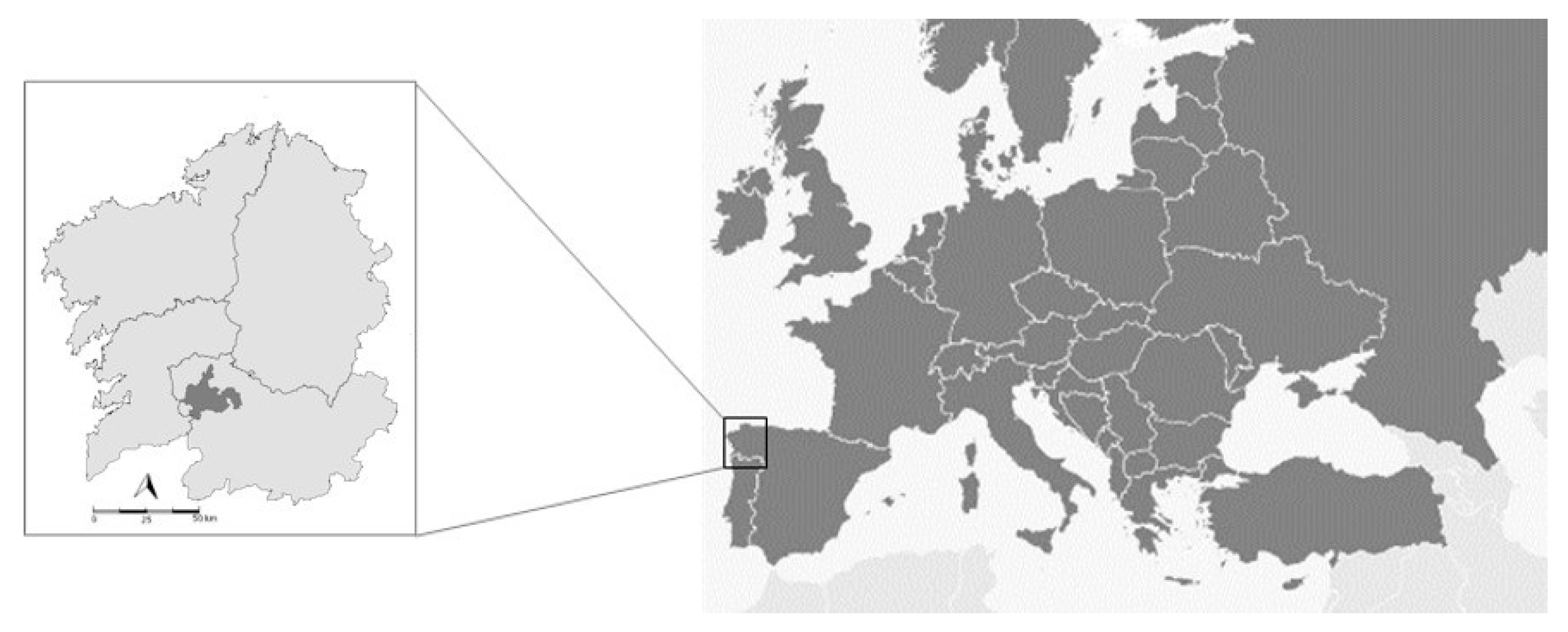
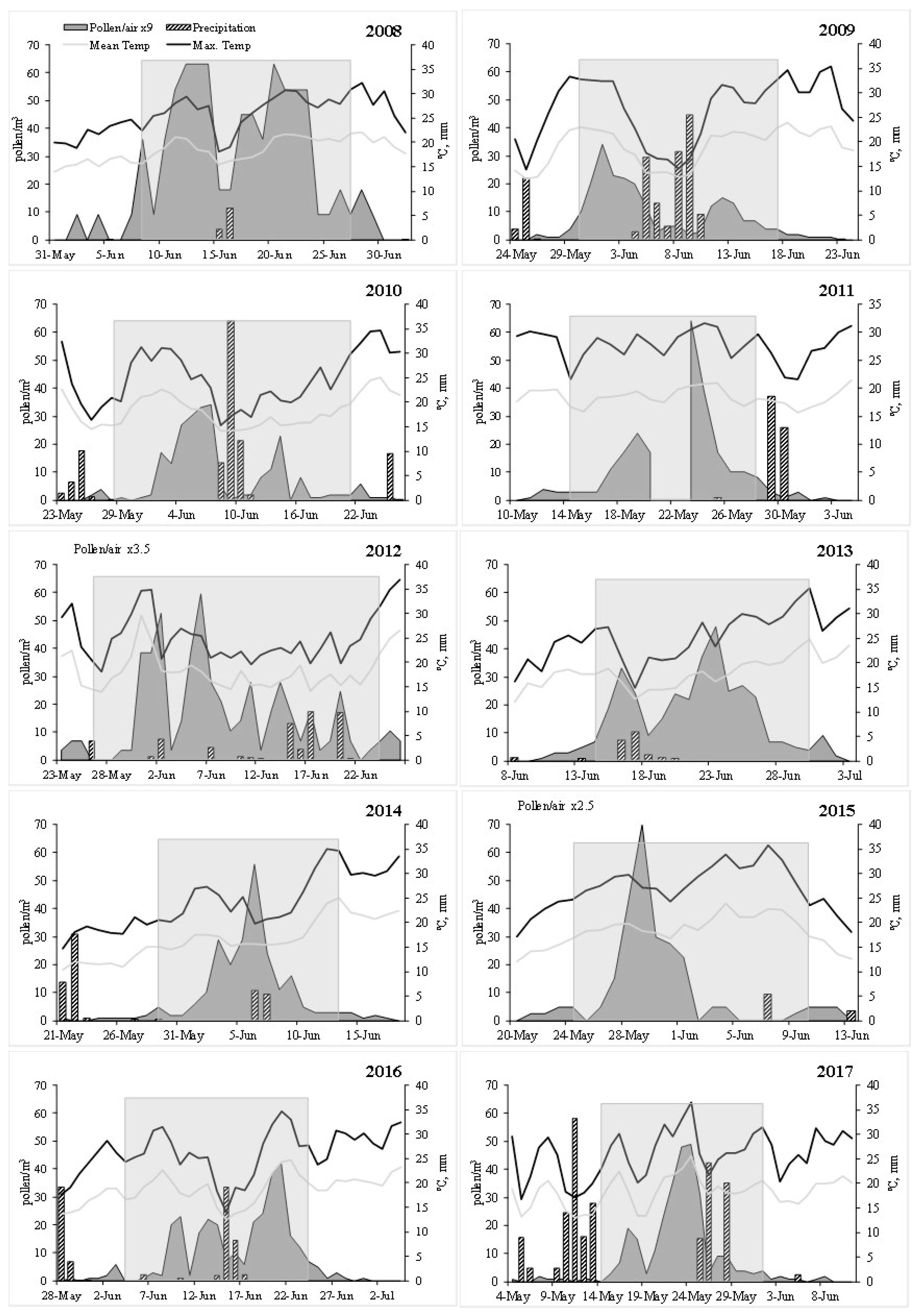
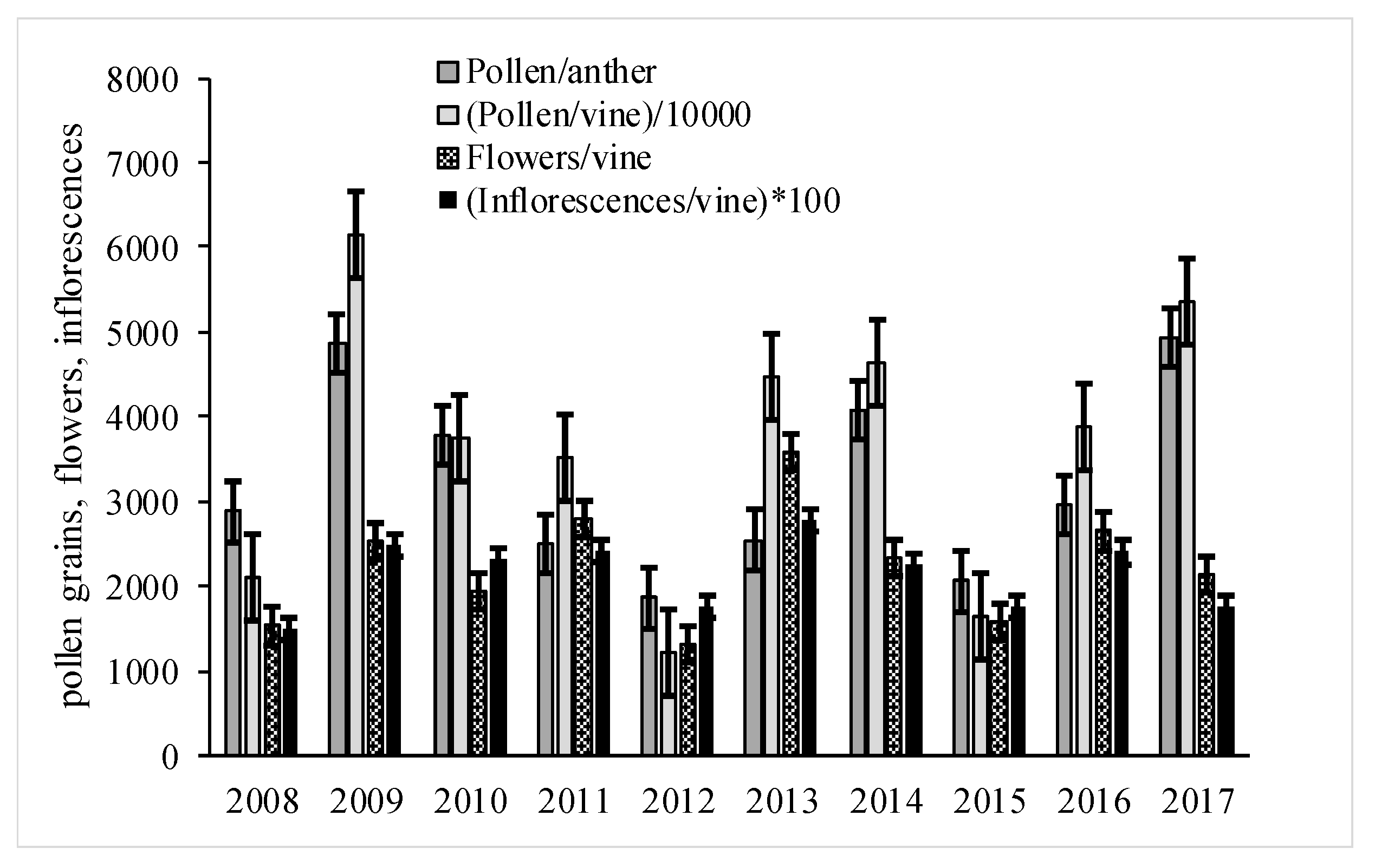
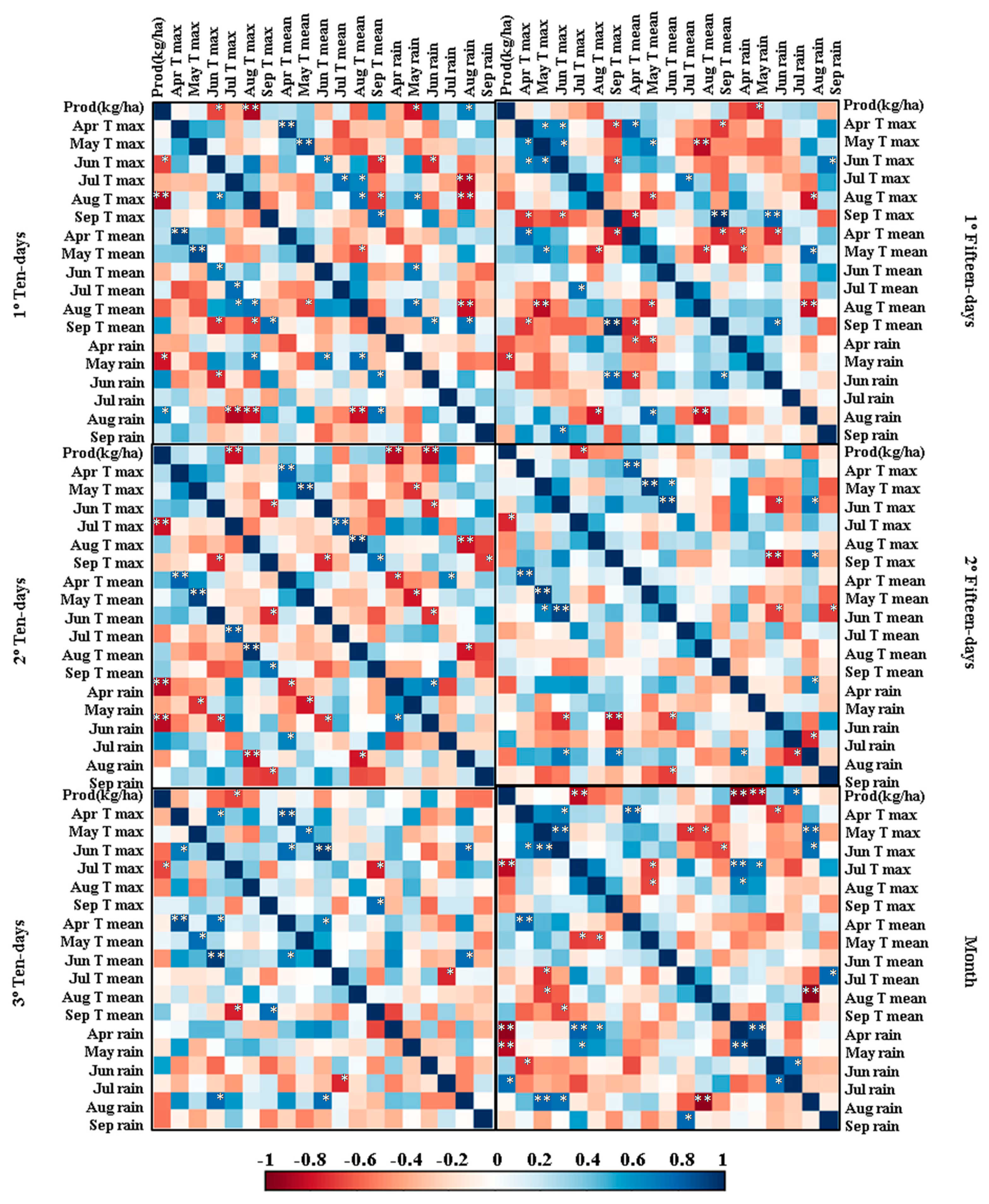
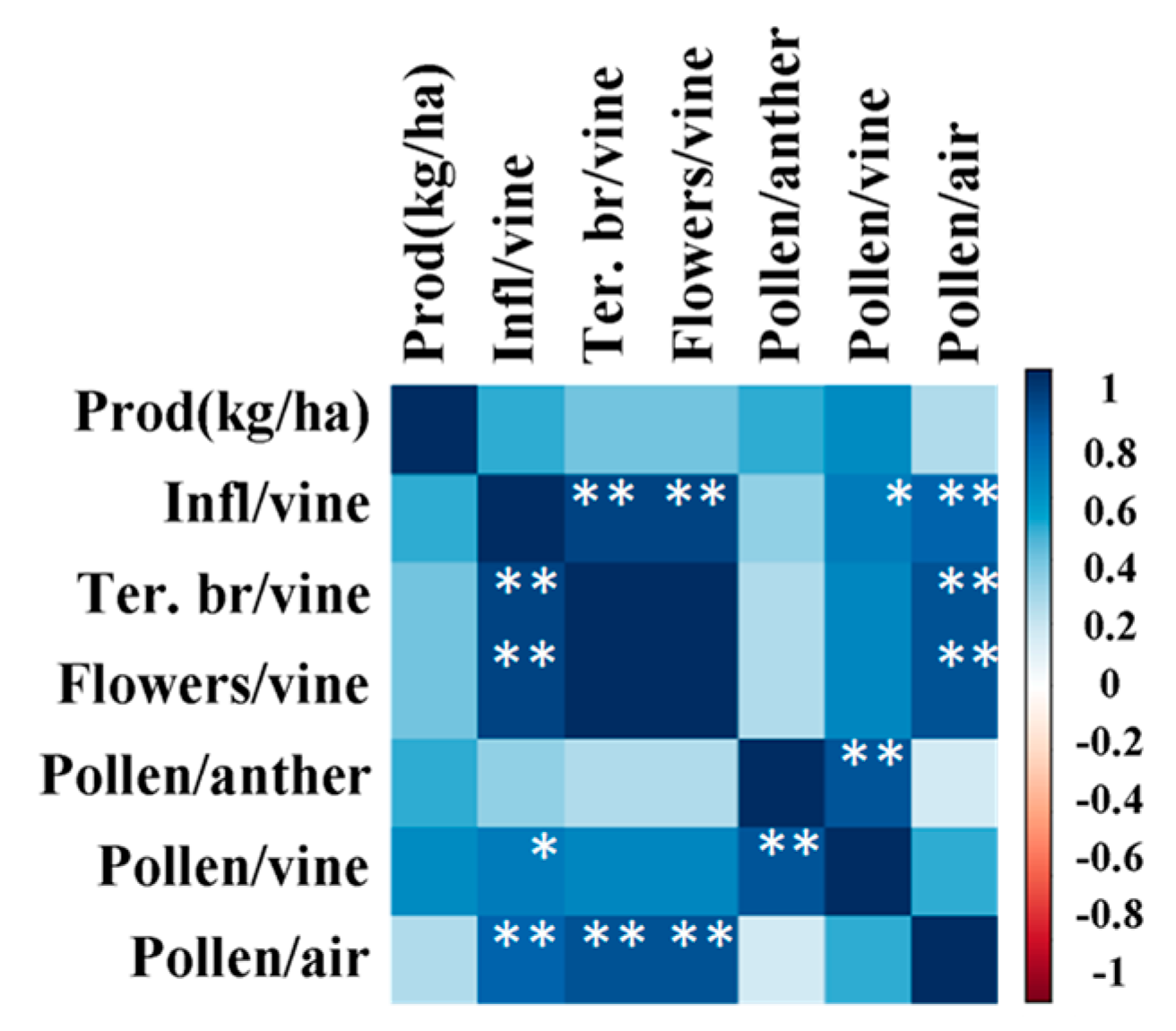
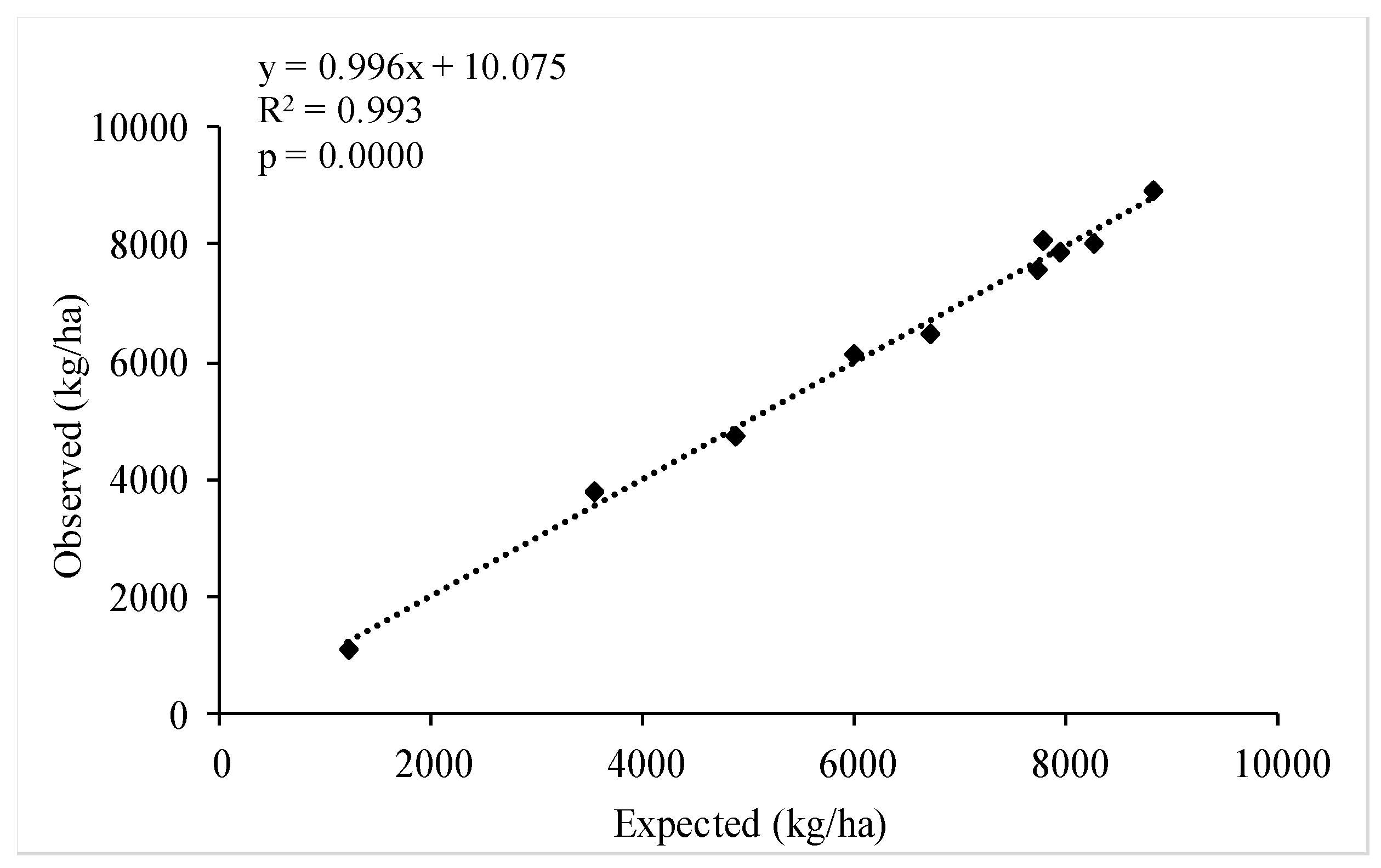
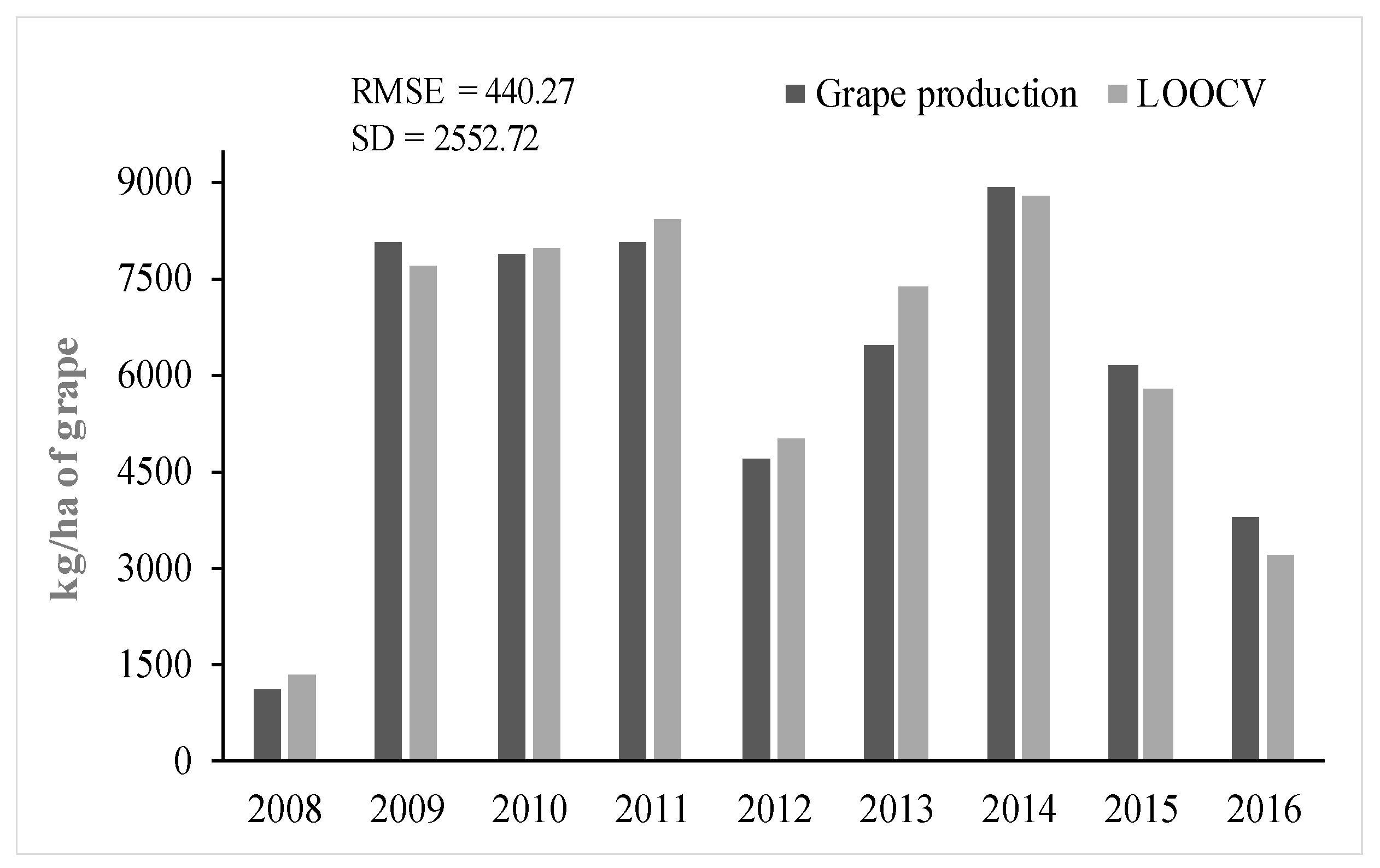
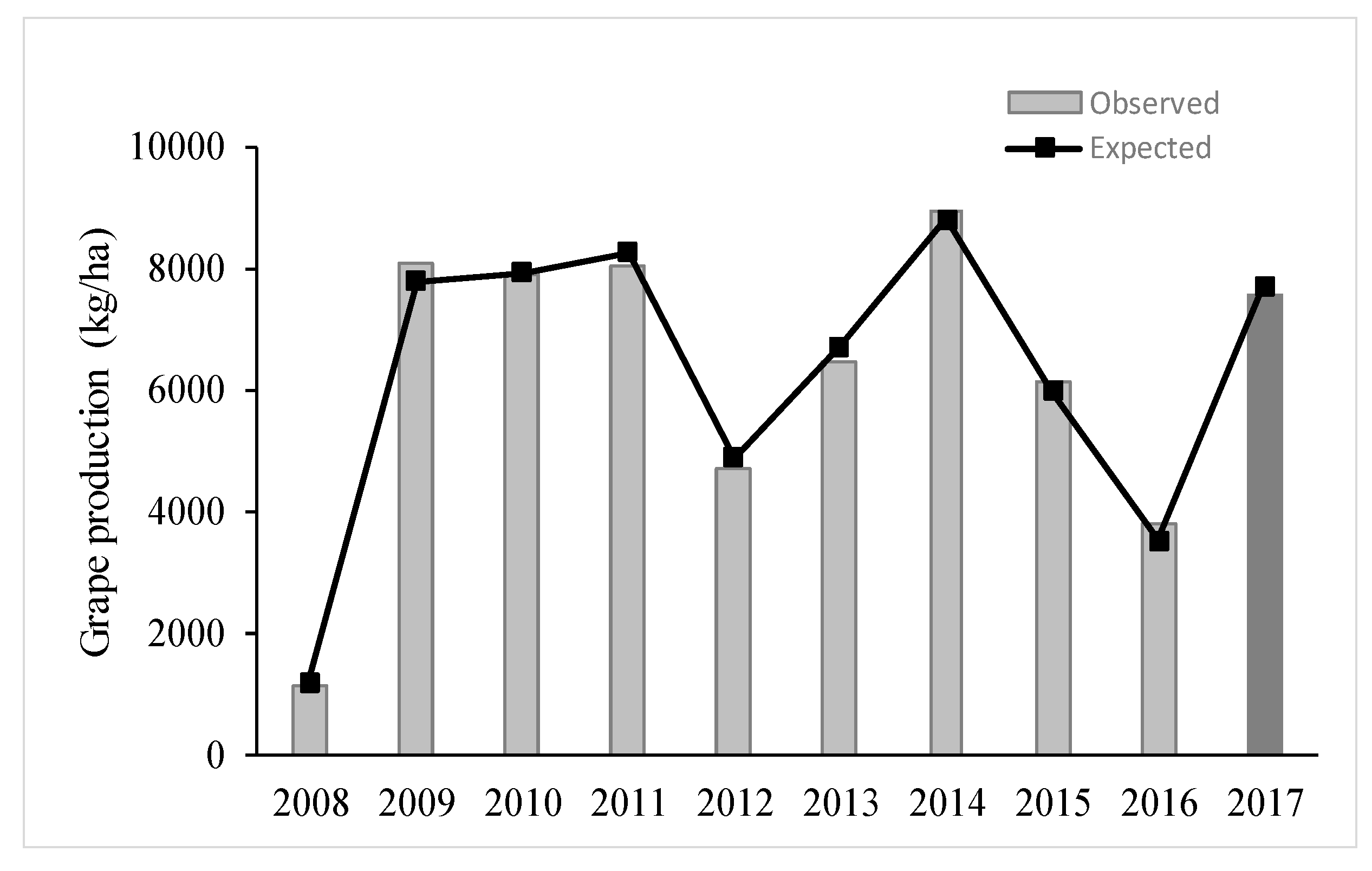
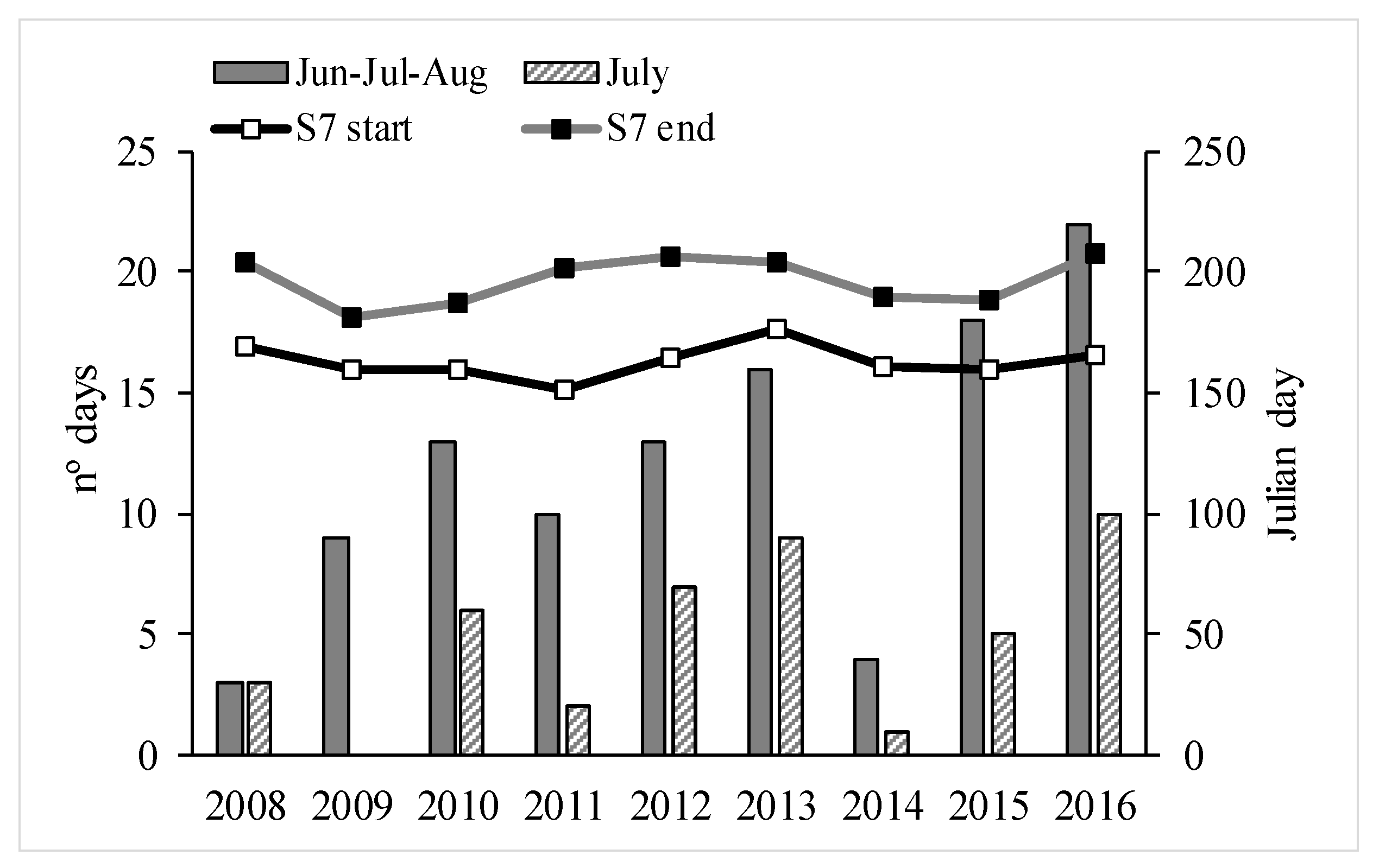
| Year | SPIn (Total Pollen) | Main Pollen Season (MPS) | Seasonal Peak | |||
|---|---|---|---|---|---|---|
| Start Date | End Date | Duration (Days) | Peak Date | Peak Value (Pollen Grains/m3) | ||
| 2008 | 84 | 8-June | 27-June | 20 | 12,13,14,20-June | 7 |
| 2009 | 222 | 30-May | 17-June | 19 | 1-June | 34 |
| 2010 | 225 | 29-May | 21-June | 24 | 7-June | 34 |
| 2011 | 226 | 14-May | 28-May | 15 | 23-May | 64 |
| 2012 | 142 | 29-May | 24-June | 27 | 6-June | 17 |
| 2013 | 336 | 14-June | 30-June | 17 | 23-June | 48 |
| 2014 | 224 | 29-May | 13-June | 16 | 6-June | 56 |
| 2015 | 94 | 24-May | 10-June | 18 | 29-May | 28 |
| 2016 | 293 | 6-June | 24-June | 19 | 21-June | 42 |
| 2017 | 282 | 15-May | 1-June | 18 | 24-May | 49 |
| Variable | Coeff (SE) a | p | R2 = 0.993 |
|---|---|---|---|
| Intercept | 10,242.150 (1356.392) | 0.00065 | Adjusted R2 = 0.989 |
| 11–20 July max. T b | −151.510 (37.282) | 0.00969 | SE = 260.95 |
| 11–20 April Rain c | −51.596 (3.409) | 0.00002 | F(3,5) = 247.80 |
| Inflorescences/vine d | 130.025 (25.490) | 0.00377 | p < 0.00001 |
| Variable | Mean | Std.Dv. | N | Diff. | Std.Dv.Diff. | t | df | p |
|---|---|---|---|---|---|---|---|---|
| Prod. Godello | 6267.910 | 2423.226 | ||||||
| Expected | 6282.283 | 2424.433 | 10 | −14.374 | 199.740 | −0.228 | 9 | 0.825 |
© 2020 by the authors. Licensee MDPI, Basel, Switzerland. This article is an open access article distributed under the terms and conditions of the Creative Commons Attribution (CC BY) license (http://creativecommons.org/licenses/by/4.0/).
Share and Cite
González-Fernández, E.; Piña-Rey, A.; Fernández-González, M.; Aira, M.J.; Rodríguez-Rajo, F.J. Prediction of Grapevine Yield Based on Reproductive Variables and the Influence of Meteorological Conditions. Agronomy 2020, 10, 714. https://doi.org/10.3390/agronomy10050714
González-Fernández E, Piña-Rey A, Fernández-González M, Aira MJ, Rodríguez-Rajo FJ. Prediction of Grapevine Yield Based on Reproductive Variables and the Influence of Meteorological Conditions. Agronomy. 2020; 10(5):714. https://doi.org/10.3390/agronomy10050714
Chicago/Turabian StyleGonzález-Fernández, Estefanía, Alba Piña-Rey, María Fernández-González, María J. Aira, and F. Javier Rodríguez-Rajo. 2020. "Prediction of Grapevine Yield Based on Reproductive Variables and the Influence of Meteorological Conditions" Agronomy 10, no. 5: 714. https://doi.org/10.3390/agronomy10050714
APA StyleGonzález-Fernández, E., Piña-Rey, A., Fernández-González, M., Aira, M. J., & Rodríguez-Rajo, F. J. (2020). Prediction of Grapevine Yield Based on Reproductive Variables and the Influence of Meteorological Conditions. Agronomy, 10(5), 714. https://doi.org/10.3390/agronomy10050714







